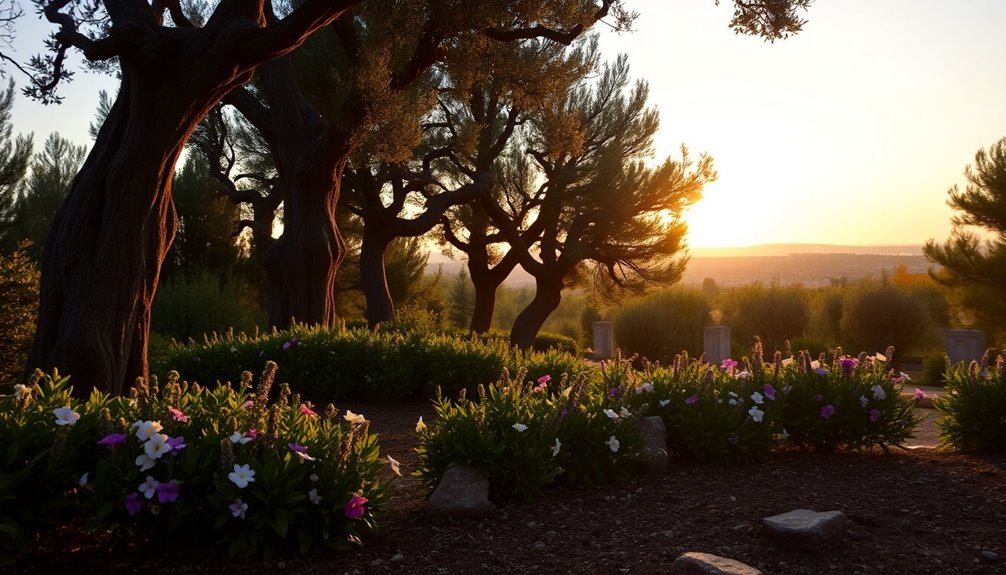The Garden of Gethsemane is where you can connect deeply with the anguish Jesus experienced before his arrest. Nestled at the foot of the Mount of Olives, this sacred site features ancient olive trees, symbolizing peace and endurance during spiritual struggles. As you reflect on the emotional turmoil faced by Jesus, you'll find a space for personal contemplation and connection with God. Many pilgrims visit to seek solace and understand the profound historical and spiritual significance of the garden. There's much more to uncover about its rich narrative and lasting impact on faith and history that awaits your discovery.
Key Takeaways
- The Garden of Gethsemane is located at the foot of the Mount of Olives, historically significant for its olive oil production.
- It is a site of profound spiritual struggle, where Jesus prayed before his arrest, exemplifying obedience to God's will.
- The name "Gethsemane" means "oil press," symbolizing the pressure Jesus faced during his anguish.
- Ancient olive trees in the garden represent peace and endurance, mirroring Jesus' perseverance through emotional turmoil.
- Gethsemane serves as a pilgrimage site, attracting millions who reflect on themes of betrayal, sacrifice, and spiritual resilience.
Introduction
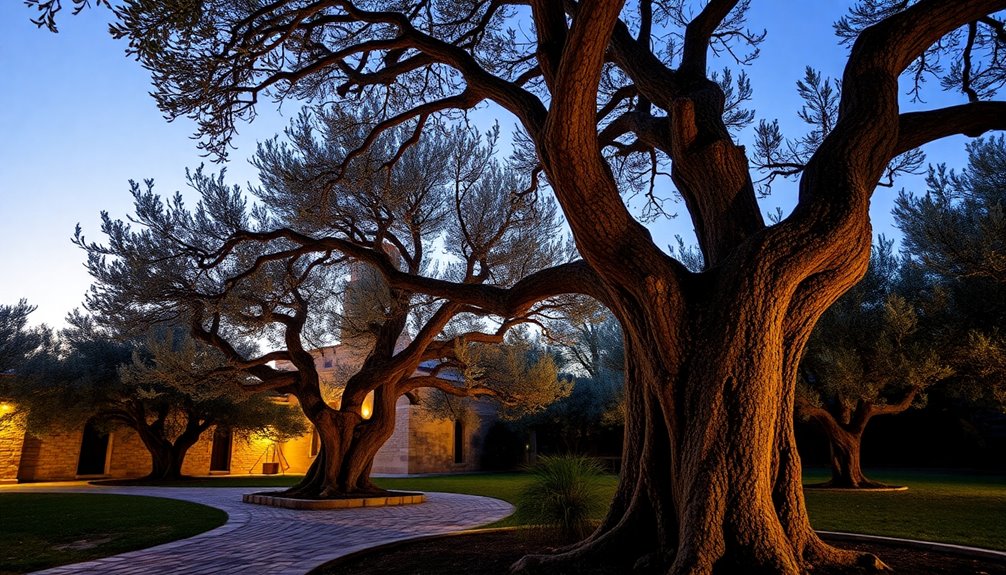
The Garden of Gethsemane is a profound site steeped in history and spirituality. Nestled at the foot of the Mount of Olives, it's where Jesus faced his deepest anguish before the crucifixion. The garden, meaning "oil press" in Hebrew, features ancient olive trees, some possibly rooted in the same soil Jesus prayed upon.
As you walk through, you can almost feel the weight of the moment when Jesus asked his disciples to stay awake during his prayer vigil, only to find them asleep.
This site has attracted pilgrims since the 4th century, drawn by its significance in Christian tradition. Various churches and shrines have been erected, marking its importance as a pilgrimage site.
The archaeological remnants, including ancient olive presses and Byzantine structures, reinforce the historical and religious authenticity of the Garden of Gethsemane. Here, you're not just visiting a location; you're stepping into a narrative that resonates through the ages.
As you reflect on the events that unfolded in this sacred space, you can deepen your understanding of the emotional and spiritual struggles Jesus experienced, making it a place of both remembrance and reverence.
Biblical Significance of Gethsemane

When you explore the biblical significance of Gethsemane, you discover its profound role in Jesus' journey to the cross.
The primary Bible references highlight His intense prayers and submission to God's will, while secondary references enrich your understanding of the prophecy surrounding His sacrifice.
This garden scene not only marks the beginning of His Passion but also reveals deep insights into His human experience.
Primary Bible References
Gethsemane stands as a profound symbol in the Gospels, encapsulating Jesus' emotional turmoil and obedience to God's will. In this sacred Garden, all four Gospels—Matthew, Mark, Luke, and John—highlight critical moments leading to Jesus' arrest.
You witness Jesus in deep prayer, grappling with the weight of His impending crucifixion. In Luke 22:44, you read that He experienced such anguish that He sweated drops of blood, illustrating His intense struggle between human desire and divine purpose.
As you explore Matthew 26:39, you find Jesus pleading for God's will to be done, showcasing His remarkable obedience. The presence of His disciples in the Garden adds to the drama, as they fell asleep during His profound moments of prayer.
This moment culminates in betrayal, as Judas Iscariot identifies Jesus with a kiss in Mark 14:44-46, setting into motion the events that lead to His arrest.
Gethsemane isn't just a location; it's a pivotal narrative of sacrifice, where Jesus confronts suffering while embodying unwavering faith in God's plan. This Garden encapsulates the essence of His mission, leaving you with a powerful understanding of obedience amid turmoil.
Secondary Bible References
As you delve into the secondary Bible references, you'll discover that Gethsemane serves as a crucial backdrop for understanding Jesus' dual nature—both divine and human. Nestled among ancient olive trees, this garden is where Jesus prayed in deep anguish, asking if the cup of suffering could be removed. Yet, He ultimately submitted to God's will, showcasing His humanity in stark contrast to His divine purpose.
The intense emotional struggle is vividly captured in Luke's account, where Jesus sweats drops of blood, revealing the depth of His distress before facing betrayal. The presence of His three disciples highlights the loneliness of His experience, as they fell asleep instead of supporting Him in prayer. This scene foreshadows the betrayal that would come, fulfilling Old Testament prophecies about the Messiah, including abandonment by His closest followers.
During His arrest, Jesus' response to violence, healing Malchus' ear, reinforces His teachings on nonviolence and love for enemies, demonstrating His commitment to a higher calling.
Gethsemane stands as a pivotal moment in the New Testament, embodying the struggle between divine purpose and human frailty.
Jewish Prayer Practices in Gethsemane
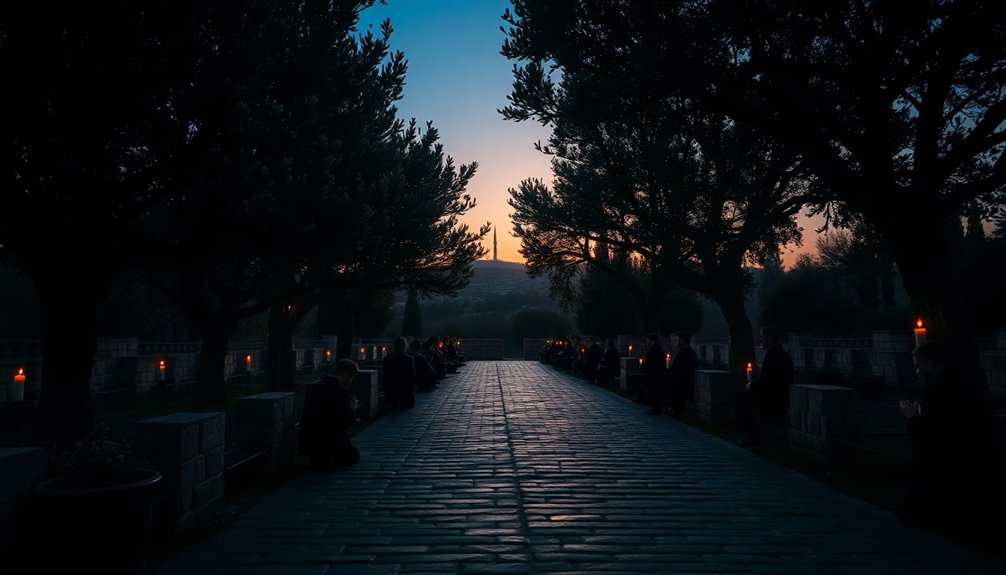
In the Garden of Gethsemane, Jewish prayer practices are deeply rooted in tradition and community. This sacred space served as a backdrop for significant moments of spiritual reflection, especially during Passover.
You can imagine the disciples engaging in communal prayer, reciting the Shema, a central declaration of faith that reaffirms their connection to God and commitment to His commandments.
As Jesus prayed fervently, he embodied the Jewish understanding of prayer as a means to seek strength and guidance in times of trouble. The atmosphere in Gethsemane was charged with requests for divine intervention, highlighting the urgency of their prayers.
The practice of maintaining a vigil, as Jesus requested of his disciples, emphasizes the importance of spiritual alertness and communal support during prayer.
In this moment, the garden became a sanctuary where the disciples could collectively confront their fears and uncertainties. The communal aspect of their prayer practices not only strengthened their bonds but also reflected a timeless tradition that continues to resonate in Jewish life today. Additionally, the significance of nighttime meditation in fostering spiritual growth and relaxation parallels the disciples' experiences in the garden.
The Garden of Gethsemane thus stands as a poignant reminder of the power of prayer amidst trials and tribulations.
Symbolism of the Olive Trees
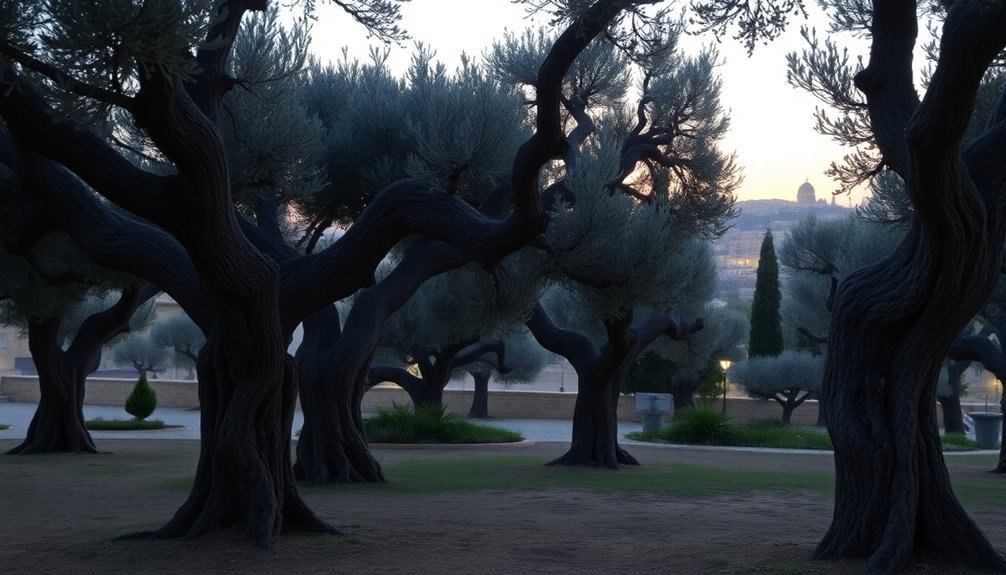
What deeper meanings might the ancient olive trees in the Garden of Gethsemane hold? These trees, which have stood for centuries, symbolize peace and endurance amid the profound spiritual struggle Jesus faced before His crucifixion.
The very name "Gethsemane" translates to "oil press," highlighting the historical significance of olive cultivation in this sacred space.
The resilience of olive trees mirrors the perseverance demonstrated by Jesus during His agony. Just as these ancient olive trees survive harsh conditions, you can reflect on the strength required to navigate life's challenges.
Each tree connects you to the cultural implications of olive oil—used for anointing, healing, and lighting—enhancing the sacredness of the events that unfolded in Gethsemane.
Archaeological studies reveal that some of these olive trees date back to AD 1092, 1166, and 1198, suggesting they may originate from the same parent plant.
Their enduring presence serves as a living testament to the historical continuity of this site, allowing you to connect with the profound moments of prayer and betrayal experienced by Jesus.
In their shadows, you can find inspiration to confront your own spiritual struggles.
Misunderstandings About Gethsemane's Significance
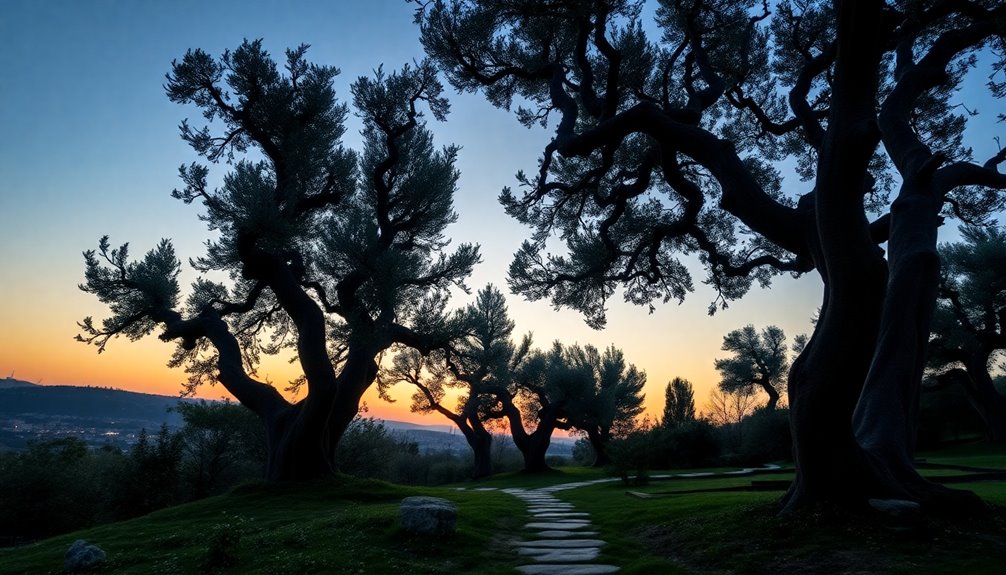
You might think of Gethsemane only as the place where Jesus was betrayed, but that misses its rich spiritual context.
It's crucial to recognize the garden as a site of intense prayer and transformation, not just a backdrop for arrest.
Debunking Common Misconceptions
Nestled in the shadow of Jerusalem, Gethsemane is often misunderstood as a tranquil garden, but this perception overlooks its profound significance. Far from being merely a serene place, Gethsemane represents a site of intense spiritual struggle for Jesus and his disciples. This is where Jesus faced the weight of betrayal and the impending crucifixion, revealing His human vulnerability and divine submission.
Many people think Gethsemane is just about Jesus' prayer, but it's much deeper. It symbolizes the pressure He endured, akin to an olive press—reflecting the historical role of the site as an olive oil production area.
The disciples' failure to stay awake during this crucial time underscores human weakness in spiritual trials, reminding us of the importance of vigilance and prayer in our own lives.
Moreover, the exact location of Gethsemane remains uncertain, as modern scholarship recognizes that various sites have been claimed over the years. Understanding Gethsemane as a place of anguish, struggle, and prophecy fulfillment enriches its significance within the context of the Holy Land, far beyond a simple garden.
Historical Accuracy Concerns
Misunderstandings about Gethsemane's significance often stem from the ambiguity surrounding its exact location. Several sites near the Mount of Olives claim to be Gethsemane, complicating historical accuracy. Early Christian pilgrimages, particularly noted by the Pilgrim of Bordeaux in 333 CE, reveal Gethsemane's recognition as a sacred site. However, the conflation of biblical accounts muddles our understanding of its true importance.
Archaeological findings, including a 1,500-year-old Byzantine church and ancient olive trees, highlight the area's early Christian reverence. Yet, these discoveries don't definitively identify where Jesus prayed and was arrested. Joan E. Taylor's 1995 article questions the traditional identification of Gethsemane, suggesting that the narrative mightn't correspond to a single, specific location but instead represents a broader misunderstanding of its historical context.
Moreover, the presence of olive trees, dated to the 12th century, can mislead visitors into thinking they're direct descendants of those during Jesus' time. In reality, these trees may not have any direct connection to His ministry, further complicating the historical narrative surrounding Gethsemane.
Understanding these nuances helps clarify the significance of this sacred site.
Spiritual Reflection During Hardship
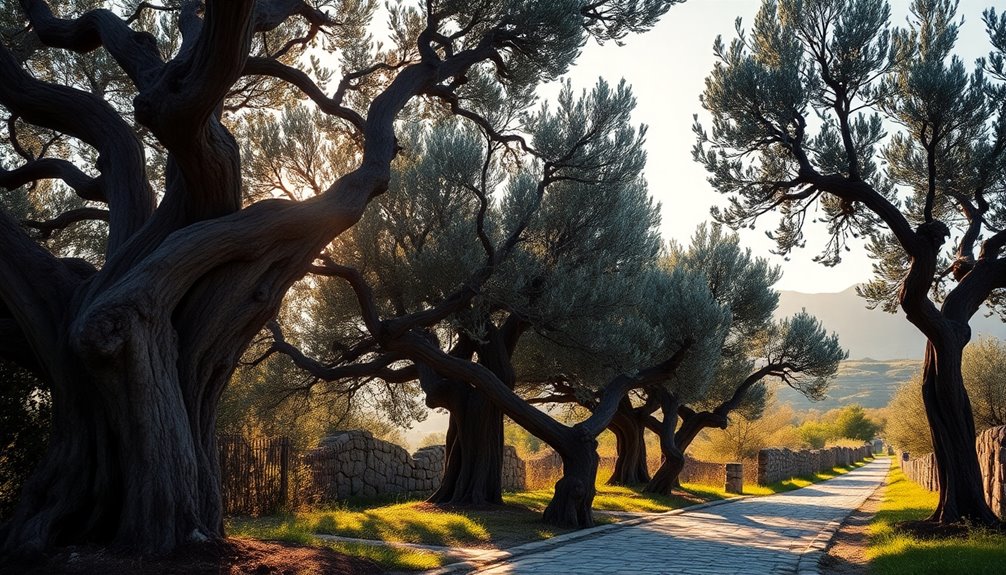
When you're facing hardship, embracing solitude in prayer can provide clarity and strength. Alternatively, gathering with a community for prayer can uplift your spirit and foster a sense of belonging. Both approaches offer valuable ways to reflect spiritually and navigate your struggles. Additionally, engaging in activities such as pet therapy can enhance emotional well-being during challenging times.
Embracing Solitude in Prayer
Solitude in prayer can be a powerful refuge during life's most challenging moments. In the Garden of Gethsemane, Jesus withdrew from His disciples, seeking divine strength amid profound anguish. Surrounded by ancient olive trees, the garden offers a tranquil space for deep spiritual reflection, reminding you that solitude can help you confront your spiritual struggles.
When faced with overwhelming challenges, like Jesus, you might feel the weight of your burdens intensify. His fervent prayers in Gethsemane, where He sweat drops of blood, illustrate the depth of emotional turmoil that accompanies significant hardship. In those moments, embracing solitude allows you to connect more intimately with your faith, providing clarity and solace that can be hard to find in the chaos of life.
While Jesus called His disciples to maintain vigilance and pray, His example shows the necessity of seeking solitude for personal reflection.
It's in these quiet moments that you can find the strength to navigate your trials. Remember, the path to resilience often lies in the stillness of prayer, away from the distractions of the world, allowing you to confront your struggles with renewed faith and focus.
Community Prayer Gatherings
Gathering in community for prayer offers a powerful complement to the solitude found in personal reflection. Inspired by the Garden of Gethsemane, these community prayer gatherings provide a space for you to confront your anguish and surrender your burdens alongside others.
During prayer vigils, you'll find strength in collective prayer as you join hearts and voices, sharing in communal lament and intercession. These gatherings encourage spiritual reflection, allowing you to express your vulnerabilities while seeking divine support.
Just as Jesus urged His disciples to remain vigilant, you too are called to stay spiritually alert during these times of distress. Local congregations often incorporate meditative practices, such as silent prayer and shared testimonies, creating an atmosphere of unity and hope.
In moments of hardship, community prayer becomes a lifeline, reminding you that you're not alone in your struggles. As you come together with others, you draw upon the spirit of Gethsemane, encouraging one another to surrender to God's will.
Through this shared experience, you'll discover the transformative power of prayer, fostering resilience and healing within yourself and your community.
Gethsemane's Enduring Spiritual Legacy
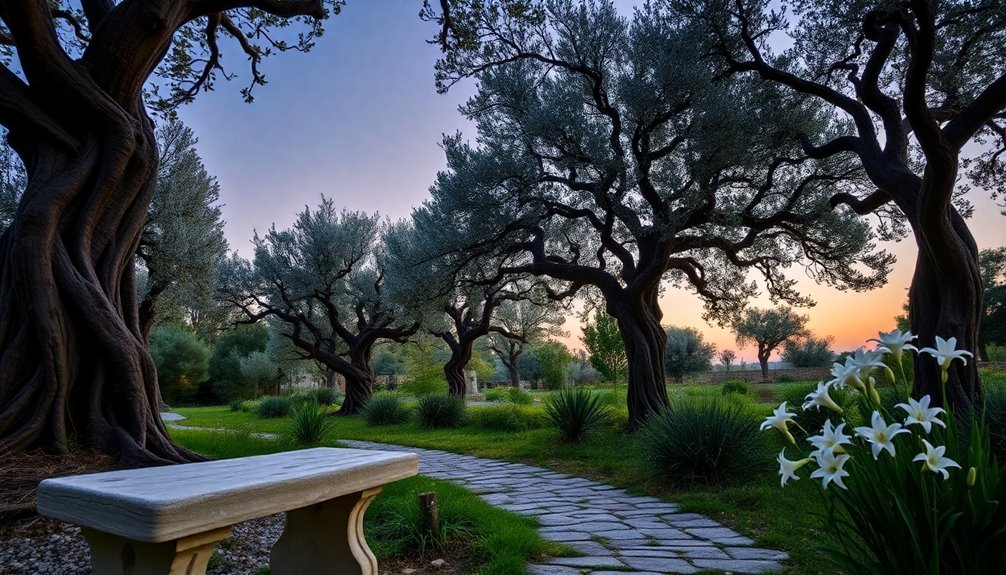
Many people find themselves drawn to the Garden of Gethsemane, a place steeped in profound spiritual significance. Here, under the ancient olive trees, Jesus grappled with His impending sacrifice, embodying the struggle between divine will and human desire. This moment of anguished prayer, highlighted in all four Gospels, resonates with your own experiences of vulnerability and the need for spiritual vigilance.
When Jesus urged His disciples to stay awake and pray, He articulated the essence of human frailty: "the spirit is willing, but the flesh is weak." This powerful reminder underscores the importance of prayer during life's trials.
Gethsemane's legacy has inspired countless artistic expressions—literature, paintings, and music—reflecting its deep emotional and theological impact on Christian thought.
As a vital pilgrimage site, Gethsemane invites millions each year to reflect on Jesus' betrayal and sacrifice. This garden encapsulates essential themes of betrayal, sacrifice, and redemption, central to understanding Jesus' mission and the core message of the Gospel.
Additional Resources
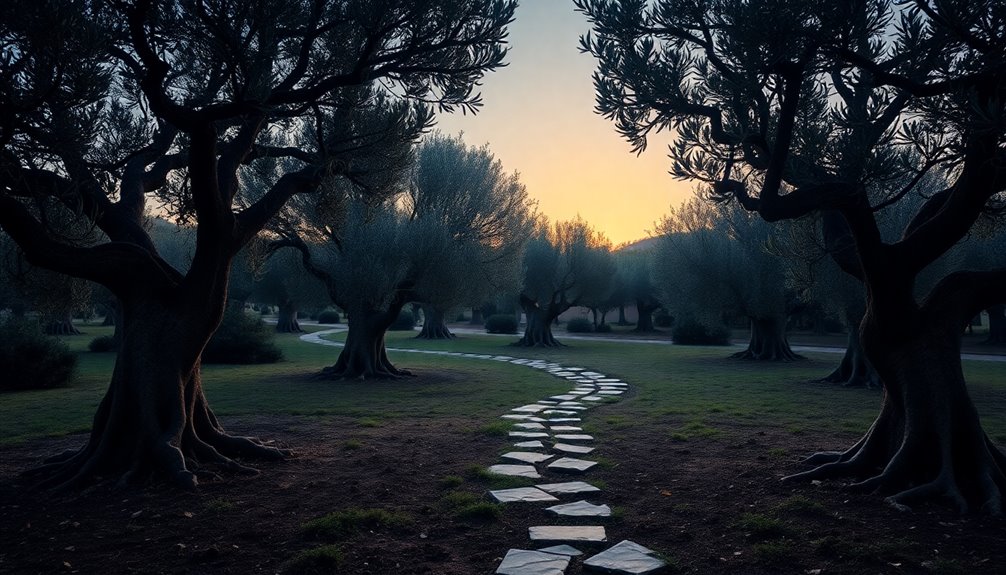
Exploring the Garden of Gethsemane's rich history and spiritual significance can be greatly enhanced by various resources available to you. The Gospels provide profound insights into Jesus Christ's agony and prayer in the garden, making them essential for your theological study and reflection.
You might also find valuable scholarly articles, like Joan E. Taylor's contributions in the Biblical Archaeology Review, which delve into alternative theories about the garden's exact location. Such archaeological discoveries, including remnants of a Byzantine church and ancient olive tree roots, highlight the historical significance of Gethsemane as a pilgrimage site.
When you visit, take time to appreciate the olive trees, some dating back to the 12th century, believed to be descendants of those present during Jesus' time. This connection enhances your spiritual experience, allowing you to reflect on the events leading to the crucifixion of Jesus.
Whether you're a Christian pilgrim or a seeker of history, these resources will deepen your understanding and foster a spiritual connection to this sacred site. Embrace the opportunity to explore the layers of meaning within the Garden of Gethsemane.
Frequently Asked Questions
What Is the Significance of the Garden of Gethsemane?
The significance of a garden often lies in its ability to symbolize growth, reflection, and transformation.
When you think about gardens, you might consider how they provide a space for solitude and contemplation. In many traditions, gardens serve as places where individuals confront inner turmoil, seek clarity, and connect with the divine.
They remind you of the balance between nature and spirituality, highlighting the importance of patience, nurturing, and the cycle of life.
Did Jesus See Every Sin in the Garden of Gethsemane?
You may wonder if Jesus saw every sin during His intense moments of prayer.
While the Gospels don't explicitly say He witnessed each individual sin, they do highlight His profound emotional turmoil regarding sin's weight.
You can interpret His agony as a reflection of the collective burden He bore for humanity.
His struggle showcases His awareness of the consequences of sin and the deep connection it creates between humanity and divine sacrifice.
What Garden Was Jesus Betrayed In?
You might be curious about where Jesus was betrayed.
He was betrayed in a garden, a place he often visited for prayer and reflection.
This garden, significant in Christian teachings, became the setting for one of the most pivotal moments in his life.
It was here that Judas Iscariot identified him to the soldiers with a kiss, leading to his arrest and the unfolding of events that would change history forever.
Why Was Jesus Crying in the Garden of Gethsemane?
You might wonder why Jesus was crying during His intense prayer.
He faced overwhelming emotional distress, grappling with the enormity of His impending suffering and the weight of humanity's sins.
In that moment, His human nature shone through as He sought solace and strength from God, expressing His desire to escape the pain.
His tears symbolized deep anguish, yet He ultimately submitted to God's will, showcasing both vulnerability and dedication.

